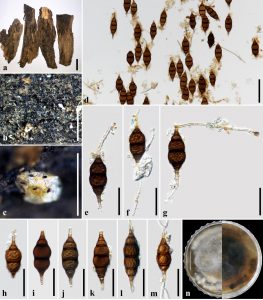Pseudoxylomyces elegans (Goh, W.H. Ho, K.D. Hyde & C.K.M. Tsui) Kaz. Tanaka & K. Hiray., in Tanaka et al., Stud. Mycol. 82: 126 (2015)
≡Xylomyces elegans Goh, W.H. Ho, K.D. Hyde & K.M. Tsui, Mycological Research 101 (11): 1324 (1997)
Index Fungorum number: IF811333
Saprobic on submerged decaying wood in a freshwater stream. Mycelium immersed in agar, pale brown to reddish brown. Asexual morph: Conidiophores macronematous, septate, flexuous, hyaline to subhyaline, smooth, up to 160 μm long. Conidiogenesis intercalary in the hyphae, gangliar-type. Conidia 50–86 × 22–34 μm (x̅ = 85.33–70.57 μm), broadly fusiform, 4–7-septate, with central two cells widest, constricted at septa, dark brown, with paler end cells, smooth at young, warty when matured, cells with granular cytoplasm Sexual morph: Undetermined.
Culture characteristics – Ascospores germinating on MEA within 24 h and germ tubes produce from anterior and basal part of conidia. Colonies on the MEA, circular, fluffy, aerial, light gray mycelium with fimbriate margin, dark brown to reddish brown reverse, 10–15 mm diam. after 15 days at 25 °C.
Material examined – Thailand, Phuket Province, Mai Khao, Thalang District, stream, on submerged wood, 5 May 2019, Mark S. Calabon, FWHY1 (MFLU 20-0554), culture MFLUCC 20-0186.
GenBank submissions – ITS: MT465322, LSU: MT447878
Known distribution (based on molecular data) – Australia (Goh et al. 1997), Brazil (Barbosa & Gusmão 2011), China (Tsui & Hyde 2004), India (Patil & Borse 2015), Japan (Tanaka et al. 2015), Seychelles (Goh et al. 1997), Thailand (Sivichai et al. 2000) and USA (Raja et al. 2007).
Known hosts (based on molecular data) – unidentified dead twig in river (Tanaka et al. 2015), unidentified dead twig in stream (Pratibha & Prabhugaonkar 2017).
Notes – Pseudoxylomyces elegans is widely distributed in the freshwater habitats and has been recorded from different countries (see known distribution) but only Pratibha & Prabhugaonkar (2017) and Tanaka et al. (2015) provided the molecular data of the species. The morphology of our collection (MFLUCC 20-0186) resembles Pseudoxylomyces elegans in having broadly fusiform, 4–7-septate, brown conidia, with paler end cells (Tanaka et al. 2015). Multi-gene phylogeny also indicates that our collection nested with Pseudoxylomyces elegans with high bootstrap support (92% ML, 0.99 BYPP). Pseudoxylomyces elegans was formerly collected from submerged baits of Dipterocarpus alatus and Xylia dolabriformis in Nakorn Ratchassima, Thailand by Sivichai et al. (2000) but the molecular data was not provided. Therefore, based on both morphology and phylogeny support, we introduce a new geographical record (Phuket, Thailand) of Pseudoxylomyces elegans.

